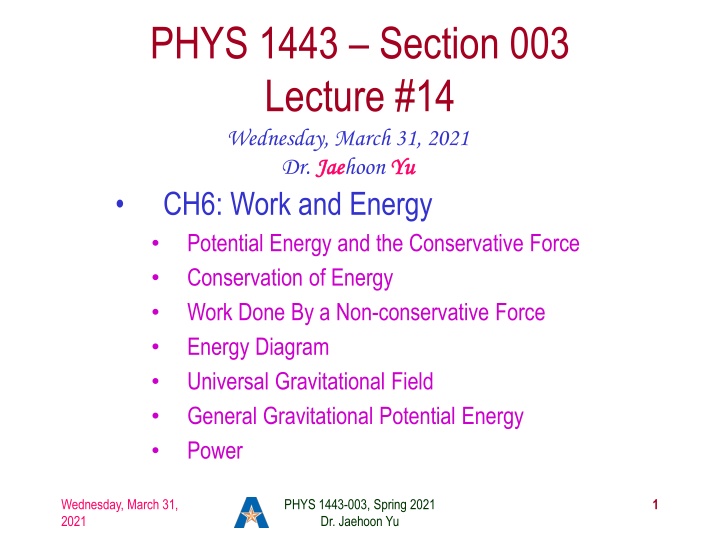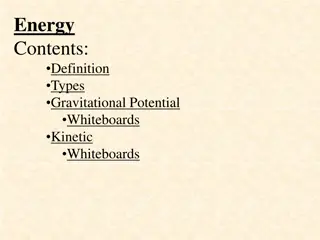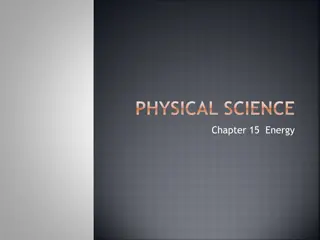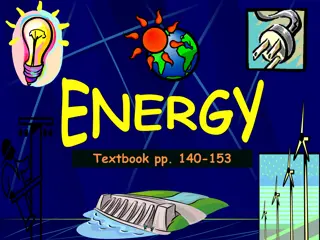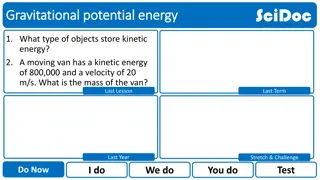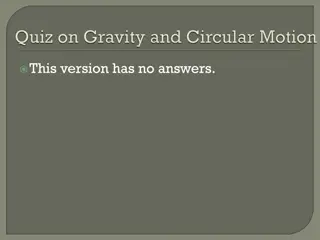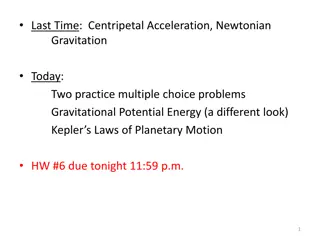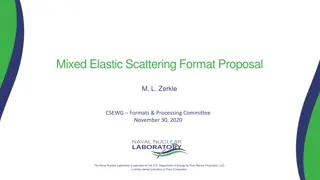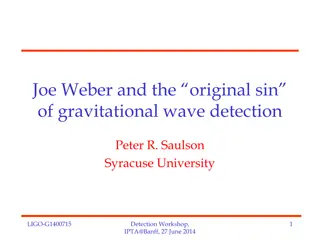Gravitational and Elastic Potential Energy Principles
Concepts of potential energy in gravitational and elastic systems, including work done by conservative forces and the conservation of mechanical energy. Understand how potential energy is calculated in different scenarios and the significance of conservative forces in energy transformations.
Download Presentation

Please find below an Image/Link to download the presentation.
The content on the website is provided AS IS for your information and personal use only. It may not be sold, licensed, or shared on other websites without obtaining consent from the author.If you encounter any issues during the download, it is possible that the publisher has removed the file from their server.
You are allowed to download the files provided on this website for personal or commercial use, subject to the condition that they are used lawfully. All files are the property of their respective owners.
The content on the website is provided AS IS for your information and personal use only. It may not be sold, licensed, or shared on other websites without obtaining consent from the author.
E N D
Presentation Transcript
PHYS 1443 Section 003 Lecture #14 Wednesday, March 31, 2021 Dr. Jae Jaehoon Yu CH6: Work and Energy Potential Energy and the Conservative Force Conservation of Energy Work Done By a Non-conservative Force Energy Diagram Universal Gravitational Field General Gravitational Potential Energy Power Yu Wednesday, March 31, 2021 PHYS 1443-003, Spring 2021 Dr. Jaehoon Yu 1
More Conservative and Non-conservative Forces The work done on an object by the gravitational force does not depend on the object s path in the absence of a retardation force. N W = mgh When directly falls, the work done on the object by the gravitation force is g = ) W = sin mg l g incline F l When sliding down the hill of length l, the work is h l g ( mg g = = mgh sin mg l How about if we lengthen the incline by a factor of 2, keeping the height the same?? So, the work done by the gravitational force on an object is independent of the path of the object s movement. It only depends on the difference of the object s initial and final position in the direction of the force. Still the same amount of work W = mgh g Forces like gravitational and elastic forces are called the conservative force 1. If the work performed by the force does not depend on the path. 2. If the net work performed on a closed path is 0. + E + = KE PE KE PE Total mechanical energy is conserved!! f f M i i Wednesday, March 31, 2021 PHYS 1443-003, Spring 2021 Dr. Jaehoon Yu 2
Example for Potential Energy A 1.8m tall bowler drops bowling ball of mass 7kg on his toe. Choosing the floor level as y=0, estimate the total work done on the ball by the gravitational force as the ball falls on the toe. Let s assume the top of the toe is 0.03m from the floor and the hand was 0.5m above the floor. mgy =7 9.8 0.5 U = = ( mgy =7 9.8 0.03 =32.24J @32J = U = U U = W = 34.3J 2.06J f f i i ) U M f i g b) Perform the same calculation using the top of the bowler s head as the origin. What has to change? First, we must re-compute the positions of the ball in his hand and on his toe. Since the bowler s height is 1.8m, the ball s original position is 1.3m, and the toe is at 1.77m. ( ) 7 9.8 1.3 89.2J = = ( f U U ( ) U = ) mgy = 7 9.8 121.4J = U = mgy = 1.77 f f i i = 32.2J @32J W = U g i Wednesday, March 31, 2021 PHYS 1443-003, Spring 2021 Dr. Jaehoon Yu 3
Elastic Potential Energy Potential energy given to an object by a spring or an object with elasticity in the system that consists of an object and the spring. The force spring exerts on an object when it is distorted from its equilibrium by a distance x s F = kx Hooke s Law distance x is x 1 1 1 1 1 The work performed on the object by the spring is f xf ( ) Ws= -kx = 2 = kx + = kx 2 f 2 i 2 i 2 f dx kx kx kx 2 2 2 2 2 xi x i 1kx Us 2 The potential energy of this system is 2 The work done on the object by the spring depends only on the initial and final position of the distorted spring. The gravitational potential energy, Ug What do you see from the above equations? Where else did you see this trend? A conservative force!!! So what does this tell you about the elastic force? Wednesday, March 31, 2021 PHYS 1443-003, Spring 2021 Dr. Jaehoon Yu 4
Conservation of Mechanical Energy E K U + Total mechanical energy is the sum of kinetic and potential energies Let s consider a brick of mass m at the height h from the ground What is the brick s potential energy? m U = mgh g mg g h What happens to the energy as the brick falls to the ground? x = gt 1 2mv f xF dx = U U U m x f i i v = The brick gains speed By how much? h1 1 2mg t = 2 2 2 The brick s kinetic energy increases to K = So what? The lost potential energy is converted to the kinetic energy!! And? The total mechanical energy of a system remains constant in any isolated system of objects that interacts only through conservative forces: Principle of mechanical energy conservation Principle of mechanical energy conservation iE = fE What does this mean? + + = K U K U i i f f Wednesday, March 31, 2021 PHYS 1443-003, Spring 2021 Dr. Jaehoon Yu 5
Example A ball of mass m at rest is dropped from the height h above the ground. a) Neglecting the air resistance determine the speed of the ball when it is at any given height y above the ground. 1 PE KE + = + K U K U 0+mgh Using the principle of mechanical energy conservation = mv + 2 mgy i i f f 2 m mgh 0 mvi2/2 1 2mv = v = ( ) 2 mg h y mg g h ( ) y 2 g h mgy mv2/2 mvf2/2 m b) Determine the speed of the ball at y if it had non-zero initial speed vi at the time of the release at the original height h. y + = + Again, using the principle of mechanical energy conservation but with non-zero initial kinetic energy!!! K U K U i i f f 0 1 1 mvi+ = mvf+ 2 2 mgh mgy 2 1 2 2 ( ) ( ) = 2 f 2 i m v v mg h y This result look very similar to a kinematic expression, doesn t it? Which one is it? ( ) y = + 2 2 v v g h f i Wednesday, March 31, 2021 PHYS 1443-003, Spring 2021 Dr. Jaehoon Yu 6
Example A ball of mass m is attached to a light cord of length L, making up a pendulum. The ball is released from rest when the cord makes an initial angle A with the vertical, and the pivoting point P is frictionless. Find the speed of the ball when it is at the lowest point, B. P ( ) = = cos = L L 1 cos h Ui= Compute the potential energy at the maximum height, h. Remember where the 0 is. L A A PE KE ( ) L 1 mgh cos mgL A A T mgh + = + K U K U m Using the principle of mechanical energy conservation 0 i i f f h{ 1mv m ( )= ( 1 mg g +mgh = 0 0 2 1 cos mgL B A 2 cos mv2/2 ) ( ) = = 2 2 v gL 2 1 cos v gL A A b) Determine tension T at the point B. 2 2 v v mg = T = = rF = ma m m Using Newton s 2nd law of motion and recalling the centripetal acceleration of a circular motion r r L cos Cross check the result in a simple situation. What happens when the initial angle A is 0? ) A cos ( ) 2v L 2v L L 2 1 gL = mg m + = + = + T m g A m g = T mg ( L ) + 2 1 cos ( gL gL = 3 2 T mg = A m How many forces do you see at point B? 2: Fg, T Wednesday, March 31, 2021 PHYS 1443-003, Spring 2021 Dr. Jaehoon Yu 7
Work Done by Non-conservative Force Mechanical energy of a system is not conserved when any one of the forces in the system is a non-conservative (dissipative) force. Two kinds of non-conservative forces: Applied forces: Forces that are external take away or add energy to the system. So, the mechanical energy of the system is no longer conserved. system is no longer conserved. external to the system. These forces can mechanical energy of the = + = ; K Wg U W W If you were to hit a freefalling ball, the force you apply to the ball is external to the system of the ball and the Earth. Therefore, you add kinetic energy to the ball-Earth system. you g = = K + W applied W U you Kinetic Friction: An internal force that causes an irreversible transformation of energy. The friction force causes the kinetic and potential energy to transfer to an internal energy. internal non-conservative = = W kf d K friction friction + = kf d = = K U E E E f i Wednesday, March 31, 2021 PHYS 1443-003, Spring 2021 Dr. Jaehoon Yu 8
Example of Non-Conservative Force A skier starts from rest at the top of frictionless hill whose vertical height is 20.0m and the inclination angle is 20o. Determine how far the skier can get on the snow at the bottom of the hill when the coefficient of kinetic friction between the ski and the snow is 0.210. 1mv = 2 ME = mgh Compute the speed at the bottom of the hill, using the mechanical energy conservation on the hill before friction starts working at the bottom 2 Don t we need to know the mass? = 2 v gh = 8 . 9 = 2 20 0 . 19 8 . / v m s h=20.0m =20o The change of kinetic energy is the same as the work done by the kinetic friction. What does this mean in this problem? Since we are interested in the distance the skier can get to before stopping, the friction must do as much work as the available kinetic energy to take it all away. K We don t know the mass! = = = = K K K f kf d f i = f d ; K f d = Since 0 K k i i k f = n mg Well, it turns out we don t need to know the mass. k k k 1 What does this mean? 2 mv ( ) K 2 2 v 2 19 8 . 2 = = i d = = 95 2 . m = No matter how heavy the skier is he will get as far as anyone else has gotten starting from the same height. . 0 2 210 . 9 80 mg g mg k k k Wednesday, March 31, 2021 PHYS 1443-003, Spring 2021 Dr. Jaehoon Yu 9
